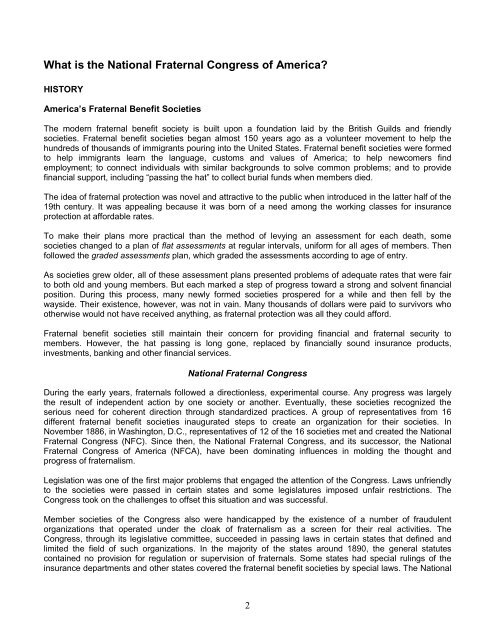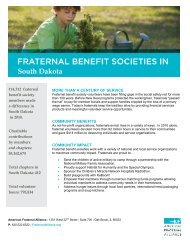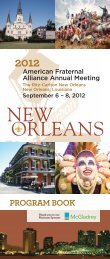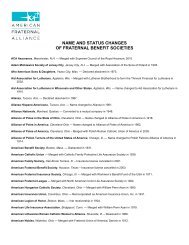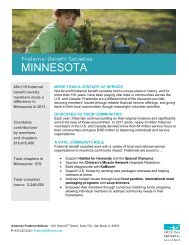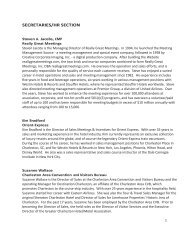OPENING PLENARY SCRIPT - American Fraternal Alliance
OPENING PLENARY SCRIPT - American Fraternal Alliance
OPENING PLENARY SCRIPT - American Fraternal Alliance
Create successful ePaper yourself
Turn your PDF publications into a flip-book with our unique Google optimized e-Paper software.
What is the National <strong>Fraternal</strong> Congress of America?<br />
HISTORY<br />
America’s <strong>Fraternal</strong> Benefit Societies<br />
The modern fraternal benefit society is built upon a foundation laid by the British Guilds and friendly<br />
societies. <strong>Fraternal</strong> benefit societies began almost 150 years ago as a volunteer movement to help the<br />
hundreds of thousands of immigrants pouring into the United States. <strong>Fraternal</strong> benefit societies were formed<br />
to help immigrants learn the language, customs and values of America; to help newcomers find<br />
employment; to connect individuals with similar backgrounds to solve common problems; and to provide<br />
financial support, including “passing the hat” to collect burial funds when members died.<br />
The idea of fraternal protection was novel and attractive to the public when introduced in the latter half of the<br />
19th century. It was appealing because it was born of a need among the working classes for insurance<br />
protection at affordable rates.<br />
To make their plans more practical than the method of levying an assessment for each death, some<br />
societies changed to a plan of flat assessments at regular intervals, uniform for all ages of members. Then<br />
followed the graded assessments plan, which graded the assessments according to age of entry.<br />
As societies grew older, all of these assessment plans presented problems of adequate rates that were fair<br />
to both old and young members. But each marked a step of progress toward a strong and solvent financial<br />
position. During this process, many newly formed societies prospered for a while and then fell by the<br />
wayside. Their existence, however, was not in vain. Many thousands of dollars were paid to survivors who<br />
otherwise would not have received anything, as fraternal protection was all they could afford.<br />
<strong>Fraternal</strong> benefit societies still maintain their concern for providing financial and fraternal security to<br />
members. However, the hat passing is long gone, replaced by financially sound insurance products,<br />
investments, banking and other financial services.<br />
National <strong>Fraternal</strong> Congress<br />
During the early years, fraternals followed a directionless, experimental course. Any progress was largely<br />
the result of independent action by one society or another. Eventually, these societies recognized the<br />
serious need for coherent direction through standardized practices. A group of representatives from 16<br />
different fraternal benefit societies inaugurated steps to create an organization for their societies. In<br />
November 1886, in Washington, D.C., representatives of 12 of the 16 societies met and created the National<br />
<strong>Fraternal</strong> Congress (NFC). Since then, the National <strong>Fraternal</strong> Congress, and its successor, the National<br />
<strong>Fraternal</strong> Congress of America (NFCA), have been dominating influences in molding the thought and<br />
progress of fraternalism.<br />
Legislation was one of the first major problems that engaged the attention of the Congress. Laws unfriendly<br />
to the societies were passed in certain states and some legislatures imposed unfair restrictions. The<br />
Congress took on the challenges to offset this situation and was successful.<br />
Member societies of the Congress also were handicapped by the existence of a number of fraudulent<br />
organizations that operated under the cloak of fraternalism as a screen for their real activities. The<br />
Congress, through its legislative committee, succeeded in passing laws in certain states that defined and<br />
limited the field of such organizations. In the majority of the states around 1890, the general statutes<br />
contained no provision for regulation or supervision of fraternals. Some states had special rulings of the<br />
insurance departments and other states covered the fraternal benefit societies by special laws. The National<br />
2


